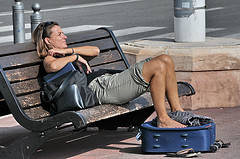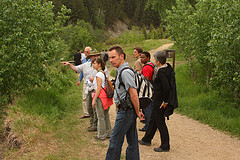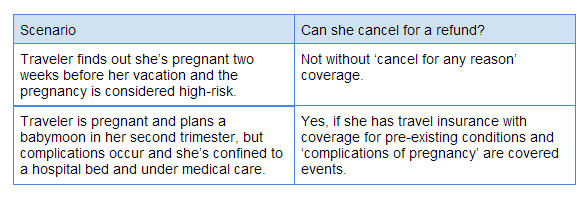 Today’s traveler knows that the initial price of their airfare is really just a reservation and not a full payment. Extra fees for services such as checking bags, priority boarding, and meals adds approximately 15 percent onto the base fare.
Today’s traveler knows that the initial price of their airfare is really just a reservation and not a full payment. Extra fees for services such as checking bags, priority boarding, and meals adds approximately 15 percent onto the base fare.
Airlines today are profitable largely due to the revenue streams from these fees and even the low-cost carriers are getting in the game, charging customers higher amounts for flight changes – a fact that makes tech-savvy travelers nuts – and even carry-on bag fees.
All of these changes affect business travelers but they’re also hard on traveling families. Here are 9 tips traveling families can save money on their trips.
1. Try to avoid airline fees
Some of the latest airline fees can hit traveling families hard. Recently, the big three airlines – American, Delta, and United – all announced increased change ticket fees. Their eye-twitch inducing $200 per seat change fee on top of any difference in the fare can hit families traveling together pretty hard when school holidays are delayed or cancelled because of missed school days due to blizzards or super storms.
It’s not just change fees families have to worry about either. Frontier airlines recently announced an incredible $100 fee for carry-on bags that have to be checked at the gate (it’s just $25 if you pay at check-in).
Avoiding the airline fees entirely is nearly impossible, but minimizing them is important to families. Research your options ahead of time and try to minimize airline fees anyway you can.
2. Don’t buy too early
While you may be tempted to get your vacation reservations made early, it’s not the best way to get the best price. The airlines and hotels are intentionally set up for higher prices early on to catch those who must book their travel (business travelers often have little choice about the timing of their trips, for example) and their prices begin to fall as the time gets closer.
Experts recommend shopping for flights well in advance using airline and hotel comparison sites like Kayak.com and Hotels.com. Set up email alerts for the dates and routes you want to travel and then wait and watch. The flights typically begin to fall between 45 and 60 days before you’d like to travel. You’ll notice the trends and have a better idea what a ‘good’ price is versus an average price pretty quickly and you’ll be ready to buy when the right one appears.
3. Go in the ‘off-season’
Yes, this is harder for families tied to school year calendars, but many schools across the U.S. are turning to year-round calendars and this is having an effect on travel. The typical summertime breaks are now scattered across the warmer months of the year and the shoulder seasons often bleed into breaks.
Depending on a whole bunch of factors, you could take the kids out of school and consider the trip an educational experience and some parents resort to doing just that without doing a lot of harm to their kids. Really.
Ideally, traveling during the off-season means going anywhere you want when the crowds are least likely to be there. This means traveling to the Caribbean during hurricane season (June 1st through November 30th), visiting Yosemite in the winter, and heading to Hawaii in September. Any way you can avoid long lines, thick crowds, and higher prices can help stretch the family’s travel dollar.
4. Avoid hotels
Sure, you’re going to have to stay somewhere but hotels are nearly always the worst option for families. There are a range of options for staying in apartments, flats, and even entire houses that cost less than an economy hotel room where everyone’s piled in on top of each other.
If you have a home or apartment here, consider exchanging with another traveler. This is often a great option for traveling families because when they partner with other families, the home is usually set up in a kid-friendly way already. There are many home exchange and vacation rental sites available online.
5. Live like a local
When you avoid staying at a hotel, it’s easier to live like a local. Families can save a lot of money by eating at least some of their meals at ‘home’. Public transportation is often cheaper than renting a car, plus many vacation rentals include bicycles which can give you and the kids some great exercise and a way to explore your destination from ground level. Ask the locals where they like to eat their meals and you’re more likely to find inexpensive and the tastiest options around.
Plus, if you decided to take the kids out of school for this break, you can use your grocery shopping trips to test their language math skills (think reading labels and calculating currency conversions).
6. Go where the dollar goes farther
If the current exchange rate is dashing your dreams of a trip to France, travel somewhere the dollar has better purchasing power. Right now, South and Central America and Canada are great options, but don’t overlook destinations like Turkey, Switzerland, and Croatia – they’ve avoided switching to the Euro and are more budget-friendly. There are many affordable destinations that are rich in culture, history, and natural beauty available on a budget.
Staying inside the U.S. is also a great way to keep costs down. If the kids haven’t yet seen every single national park, it’s a great time to visit them and show your support – especially as they’re working hard to keep the parks open during a budget crisis.
7. Look for cheap and free things to do
Many destinations have local coupon books that give you discounts on attractions. Many larger cities like Chicago, Boston, and Atlanta (to name just a few) have CityPASS. These passes combine offers from a lot of attractions over a period of days and the more people you have, the more you save.
When it comes to finding free things to do, all it takes is a little research. After all, even the famous Louvre in Paris has free admission when visitors fall into certain categories or visit on certain days. City parks, biking and hiking trails, and more – there are always free things families can do to stretch their travel dollars. After all, families where you’re going need to save money too. While you’re living like a local, ask other families what things they like to do and see.
8. Insure your trip
If you do have to cancel your trip for unavoidable reasons, trip cancellation protection means you’ll be able to be reimbursed for your pre-paid trip costs. With many hotels now committed to strict cancellation fees in exchange for lower room prices, many travelers are also stuck footing that bill when they have to cancel.
Often, simply cancelling the trip, making a claim on your travel insurance, and going another time is cheaper than trying to navigate the change fees and cancellation rules. Just make sure you’re cancelling your trip for a reason that’s covered by your travel insurance plan.
Stretch your travel dollars by choosing a family travel insurance plan that covers kids at no extra charge. Just make sure that all the kids are related to you. Travel insurance plan only covers those dependents who are related, i.e., not your child’s best friend.
9. Avoid unexpected medical costs
If you’re traveling outside your health insurance network, take a little time to get travel medical insurance. The cost of medical care is rising around the world and some countries refuse to treat travelers beyond life-saving measures when they’re not citizens of the country.
To get a doctor to treat you at a hospital in Costa Rica, for example, you’ll need a major credit card just to get things started. Travel medical insurance can be as cheap as a dollar day for most travelers, so it’s really a no-brainer.









